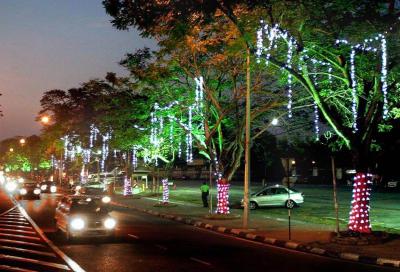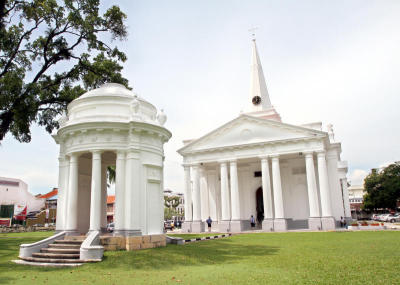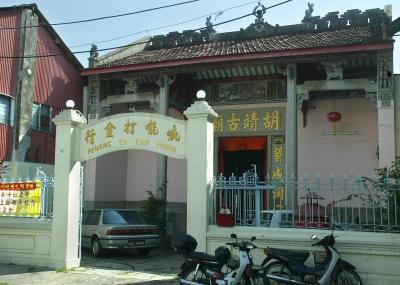 Glowing: Light Street all lit up with LED bulbs, giving the street a vibrant look.
Glowing: Light Street all lit up with LED bulbs, giving the street a vibrant look. FOUR buildings still stand majestically along Farquhar Street today — the High Court, Cathedral of the Assumption, St Xavier’s Institution (SXI) and St George Church, the oldest Anglican church in Southeast Asia.
Farquhar Street is named after Robert Townsend Farquhar, the Lieutenant Governor of Penang from 1804 to 1805.
Work on the original site of the court building started in 1809, and was completed and inaugurated in 1903. It was the work of a team of engineers headed by Singapore-based John Henry McCallum, the Surveyor General of the Straits Settlements.
The Church of Assumption moved to its present site, just next to SXI, in 1857. The church was built by the Eurasian community who had followed Captain Francis Light to Penang from Phuket, Thailand.
Facing religious persecution there, the Catholics, led by Bishop Arnaud-Antoine Gamault, fled to Kuala Kedah before landing in Penang.
They landed in 1786 on the eve of the Feast of Assumption and set up their church on Church Street before moving to Farquhar Street.
 Proud heritage: The newly restored St George’s Church has stood proudly in Farquhar Street for close to two centuries.
Proud heritage: The newly restored St George’s Church has stood proudly in Farquhar Street for close to two centuries. I have lost count of the number of times I went down on bended knees in front of the Virgin Mary’s statue outside the church, praying for divine intervention because I did not prepare myself for the school examinations!
The St George Church was completed in 1818 by the Colonial Chaplain, Rev Robert Sparke Hutchings, who founded the Penang Free School (PFS) two years earlier in 1816.
The current Hutchings School, which is just next to the church and the present Penang State Museum, was where PFS originally began. It was renamed Hutchings School after the founder when PFS moved to its current premises in Jalan Masjid Negeri.
But for today, I shall not talk about my rival school because the biggest impact on my life was SXI, my alma mater. I had my primary and secondary education in that school.
The best memories of my school life remain vivid until today, shaping my worldview, and more importantly helping me forge a great many memories with people of other races.
We were united in one thing — we were Xaverians.
Ironically, SXI started off as a Malay language school in a hut cleared from a jungle in 1787 — just a year after Capt Light landed. It was only in 1825 that an English medium school took shape and was named the St Francis Xavier’s Free School, with the La Salle brothers taking over the management.
I entered SXI in 1968 as a Standard One pupil, and classes began at 1pm. The morning session was for the secondary students only.
The humidity of the tropical Malaysian weather certainly did not help us eager students. Most of us were already soaked with sweat from running around before the assembly.
But those were the best times of our life. It was the time of the beehive hairstyle and butterfly-rimmed glasses, so accurately depicted by Lat in his cartoons. Women teachers came in samfoo or cheongsam and they always looked terrifying to us.
Somehow, many of them were bosomy. I do not know whether it was truly their physique or just our imagination.
But we were just in Standard One, so it could not have been because our teenage hormones were raging uncontrollably.
I had some unusual memories. One Cikgu Nordin, who rode his Vespa to school, taught me Bahasa Malaysia. He was fairly good but had the sadistic tendency of pinching the nipples of students who failed to meet his requirements. I was one of them.
 Meeting place: The Goldsmith’s Guild in Muntri Street it is the oldest goldsmith association in the country.
Meeting place: The Goldsmith’s Guild in Muntri Street it is the oldest goldsmith association in the country. But I wished he knew that I went on to study Malay Literature in Sixth Form and in my first year in Universiti Kebangsaan Malaysia, I enrolled in the Malay Letters Department.
SXI has produced many famous Malaysians — the first chief minister of Penang, the late Tan Sri Wong Pow Nee, Opposition veteran Karpal Singh, Cabinet minister Tan Sri Nor Mohamed Yakcop and composer Jimmy Boyle, who wrote the classic Putera Puteri.
The school, for a long, long time, remained the only one in Malaysia with a full-fledged orchestra where students got to learn to play the violin and other instruments for free.
My biggest regret was not picking up any of the skills, thinking it would a sissy thing for me to do so. The school band also, until today, has a corp of bagpipers.
The school canteen had one of the best variety of Penang hawker fare including char koay teow, wantan mee, prawn mee, curry mee, assam laksa, nasi Melayu and mee mamak.
In the 1970s and early 1980s, for 50sen, we could still get a plate of char koay teow with an egg and a prawn.
There was even a dental clinic operated by an assistant within the school premises. It terrified us whenever she came to class to hand- pick a number of us for checks.
The clinic was located next to the Brothers’ quarters, which was out of bounds to us, adding an air of mystery as to how they lived.
Adjacent to Farquhar Street is Light Street, which was the settlement’s first road. It was, of course, named after Capt Light.
According to Khoo Salma Nasution, for his “first municipal act”, Light sank a public well at the end of Light Street — the one-acre Well Estate is now part of the Convent grounds.
Capt Light is said to have stayed to the west of the Well Estate, on the site which is now the St Xavier’s field.
According to her, he lived with his Eurasian-Thai wife Martina Rozells in a bungalow on the site of the SXI field. After his death, she married one John Timmers, and they continued to stay at the bungalow.
The Leith Street Ghaut, located next to the SXI field, used to house several government quarters, and was formerly called Martina Lane, in honour of Light’s wife.
I spent countless hours at the field, where I played football and hockey, and I cannot think of any school where we could just walk to the end of the field to enjoy the sea breeze and watch the waves hit the sea walls. Students were banned from fishing but there were always occasions when the rule was breached!
Then, there were the peeps into the Convent Light Street (CLS) just across the road. CLS is the oldest girls’ school in the country and was founded by three French Sisters of the Holy Jesus Mission who arrived in Penang in 1852. It was our good fortune that the school shared the same field with us.
Inside the school compound stood the Government House which was Light’s former town property.
It housed the Governor’s Office and Council Chambers, wrote Khoo, with the building completed before Farquhar left.
Governor Philip Dundas arrived with a number of staff including a young Stamford Raffles, who was then an assistant secretary.
It is almost certain that Raffles, who went on to discover Singapore, spent a large part of his time attending to his duties at this building.
The side portion of SXI faces Love Lane. It is an attractive, even intimate, name for a road and has given rise to many versions as to its origins.
Until the late 1970s, at least one or two budget hotels were known as brothels.
Some said Love Lane, or “ai cheng hang” as the Hokkiens called it, was so named because sailors used to meet their local lovers there with its large Eurasian community around the church while others claimed the name originated from its association with the local Chinese rich kept their mistresses by the adjacent road, Muntri Street.
In fact, at least one house there had a horse stable. For a while, the stable was converted into rented homes but now, it has become a boutique hotel, appropriately named The Mews. Muntri Street – where the school backyard faces – was also a dropoff point for parents who sent their children to SXI.
The word “Muntri” is said to mean Mentri or Minister in Malay. One version has it that it was named after Ngah Ibrahim, the son of Long Jaafar, who developed the tin mining district of Larut in Perak. In fact, there is also a Larut Lane not far from Muntri Street.
Many clan associations and trade guilds used to be lined up along the street but small hotels have sprouted in this area. These old associations, facing dwindling membership, have found it hard to continue operating.
Young people find no relevance and need for such associations, formed to protect the interest of the early Chinese settlers, but they remain an important part of Penang’s history.
A few of the buildings appear to look like temples as they served dual functions — the trade and religious aspects. They include the Hainan Association Temple, where most of the members were coffeeshop and restaurant operators. They were the ones who would run the Dragon Dance performances.
The Cantonese dominated the Goldsmith Association, or ta kam hong as it is still called. Founded in 1852, it is the oldest goldsmith association in the country and dedicated to Wu Ching, the deity of goldsmiths.
The best part about growing up in Penang is that George Town’s history truly comes alive in our surroundings.
Related Stories:
Readers write





